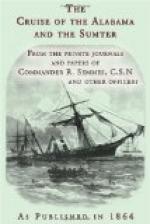Tuesday, October 28th.—Weather cloudy; wind light from the north, hauling to the eastward. The heavy sea, from the effects of the gale yesterday, continued all day rolling and tumbling us about, and keeping the deck flooded with water. In the morning watch descried a brig running off to the southward. She being some distance off, and running in the wrong direction, we did not chase. Soon afterwards another sail was reported to the westward, standing in our direction; shaped a course to head her off, and at 11 A.M., having approached her within half a mile, hoisted the English blue. The stranger showing United States colours, we hoisted our own, and hove him to with a gun. Brought the master on board with his papers, and finding the cargo condemnable, got the crew on board, fired the ship, and filled away.
The prize proved to be the barque Lauretta, of Boston, from New York, for Madeira and the Mediterranean. Received papers as late as the 24th. The intelligence of our captures (as late as the Brilliant) seems to have created great alarm for the safety of commerce in New York.
CASE OF THE LAURETTA.
This ship being under American colours, with an American (U.S.) register, no question arises as to the ship. There are two shippers of the cargo, Messrs. Chamberlain, Phelps, and Co., and Mr. H.J. Burden, both houses of New York city. Chamberlain, Phelps, and Co. ship 1424 barrels of flour, and a lot of pipe staves, to be delivered at Gibraltar or Messina, to their own order; and 225 kegs of nails to be delivered at Messina, to Mariano Castarelli. The bill of lading for the flour and staves has the following indorsement, sworn to before a notary: “State, city and county of New York: Louis Contenein being duly sworn, says, that he is a clerk with Chamberlain, Phelps, and Co., and that part of the maize in the within bill of lading, is the property of subjects of the King of Italy.” This certificate is of no force or effect for its generality; it points to no one as the owner of the merchandise, and no person could claim it under the certificate. See 3rd Phillimore, 596. Farther: the property is consigned to the order of the shipper. The title, therefore, remains in him, and cannot be divested in transitu. See 3rd Phillimore, 610-12. The contingent destination of this property, too, shows that it was property for a market. It was to be delivered either at Gibraltar or Messina, as the shipper might determine—probably on advices by steamer, before the ship should reach her destination. She was to stop, as we have seen, at Madeira, which would give ample time for the decision.




